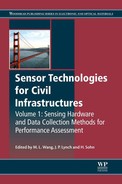Table of Contents
Woodhead Publishing Series in Electronic and Optical Materials
1. Introduction to sensing for structural performance assessment and health monitoring
1.3 Overview of sensors and sensing system hardware
1.4 Overview of sensor data interrogation and decision making
1.5 Overview of application of sensing systems to operational infrastructure
2. Sensor data acquisition systems and architectures
2.2 Concepts in signals and digital sampling
2.3 Analog-to-digital conversion
2.4 Digital-to-analog conversion
2.6 Optical sensing DAQ system
2.7 Conclusion and future trends
3. Commonly used sensors for civil infrastructures and their associated algorithms
3.2 Brief review of commonly used sensing technologies
3.4 Examples of continuous monitoring systems
3.5 Conclusions and future trends
4. Piezoelectric transducers for assessing and monitoring civil infrastructures
4.2 Principle of piezoelectricity
4.3 Piezoelectric materials and the fabrication of piezoelectric transducers
4.4 Piezoelectric transducers for SHM applications
4.6 Limitations of piezoelectric transducers
4.7 SHM techniques using piezoelectric transducers
4.8 Applications of piezoelectric transducer-based SHM
5. Fiber optic sensors for assessing and monitoring civil infrastructures
5.2 Properties of optical fibers
5.3 Common optical fiber sensors
5.5 Sources for further information and advice
6. Acoustic emission sensors for assessing and monitoring civil infrastructures
6.2 Fundamentals of acoustic emission (AE) technique
6.3 Interpretation of AE signals
6.7 Field applications and structural health monitoring using AE
7. Nonlinear acoustic and ultrasound methods for assessing and monitoring civil infrastructures
7.2 Fundamentals of nonlinear acousto-ultrasound techniques
7.3 Harmonic and subharmonic generation
7.5 Nonlinear resonance ultrasound spectroscopy
8.2 Brief history of ground penetrating radar (GPR) systems
8.3 Current challenges and state of the art systems
8.5 Electromagnetic interactions with materials
8.6 Transmitter and receiver design
8.8 Laboratory and field studies
8.9 Conclusions and future trends
9. Electromagnetic sensors for assessing and monitoring civil infrastructures
9.1 Introduction to magnetics and magnetic materials
9.2 Introduction to magnetoelasticity
9.3 Magnetic sensory technologies
9.4 Role of microstructure in magnetization and magnetoelasticity
9.5 Magnetoelastic stress sensors for tension monitoring of steel cables
9.8 Removable (portable) elastomagnetic stress sensor
9.9 Conclusion and future trends
10. Micro-electro-mechanical-systems (MEMS) for assessing and monitoring civil infrastructures
10.2 Sensor materials and micromachining techniques
10.6 Long term technical challenges
10.7 Conclusion and future trends
10.8 Sources of further information and advice
11. Multifunctional materials and nanotechnology for assessing and monitoring civil infrastructures
11.2 Properties of carbon nanomaterials
11.3 Cementitious-based composites
11.4 Fiber-reinforced polymer composites
11.6 Conclusion and future trends
12. Laser-based sensing for assessing and monitoring civil infrastructures
12.3 Laser interferometry or electronic speckle pattern interferometry
12.4 Laser digital shearography
12.5 Laser scanning photogrammetry
12.8 Other laser-based techniques
12.9 Civil infrastructure applications
13. Corrosion sensing for assessing and monitoring civil infrastructures
13.3 Corrosion evaluation techniques
13.4 Corrosion sensors for field monitoring
13.5 Conclusion and future trends
14. Vision-based sensing for assessing and monitoring civil infrastructures
14.2 Vision-based measurement techniques for civil engineering applications
14.3 Important issues for vision-based measurement techniques
14.4 Applications for vision-based sensing techniques
15. Robotic sensing for assessing and monitoring civil infrastructures
15.2 Vision-based robotic sensing for structural health monitoring (SHM)
15.3 Remote robotic sensing for SHM
15.4 Vibration-based mobile wireless sensors
15.5 Conclusions and future trends
16. Design and selection of wireless structural monitoring systems for civil infrastructures
16.2 Overview of wireless networks
16.3 Hardware design and selection
16.4 Wireless sensor network software
16.5 Conclusion and future trends
17. Permanent installation of wireless structural monitoring systems in infrastructure systems
17.2 Case study I – The Golden Gate Bridge, San Francisco, California, USA
17.3 Case study II – The Stork Bridge, Winterthur, Switzerland
17.4 Case study III – Jindo Bridge, Haenam/Jindo, South Korea
17.5 Case study IV – New Carquinez Bridge, Vallejo/ Crockett, California, USA
18. Energy harvesting for infrastructure sensing systems
18.2 Harvester dynamic modeling
18.3 Power availability and the optimal harvesting admittance
18.4 Power extraction circuits
